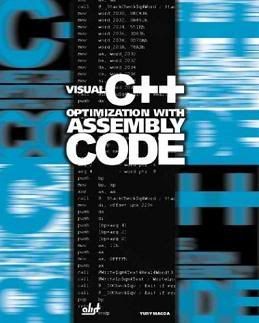
Author(s) : Yury Magda
Publisher : A-LIST
Year : May 2004
ISBN : 193176932X
Language : English
Pages : 464
File type : CHM
Size : 134.3 MB (book + source code)
Describing how the Assembly language can be used to develop highly effective C++ applications, this guide covers the development of 32-bit applications for Windows. Areas of focus include optimizing high-level logical structures, creating effective mathematical algorithms, and working with strings and arrays. Code optimization is considered for the Intel platform, taking into account features of the latest models of Intel Pentium processors and how using Assembly code in C++ applications can improve application processing. The use of an assembler to optimize C++ applications is examined in two ways, by developing and compiling Assembly modules that can be linked with the main program written in C++ and using the built-in assembler. Microsoft Visual C++ .Net 2003 is explored as a programming tool, and both the MASM 6.14 and IA-32 assembler compilers, which are used to compile source modules, are considered.
As one of the most powerful development tools, the Microsoft Visual C++ .NET development environment offers the programmer a wide variety of features for the development of applications of any type and level of complexity. Nevertheless, most serious applications are written with much manual work. This is because none of the high-level language development tools can provide maximum performance. This is the truth based on the structure and semantics of high-level languages.
A possible solution to the application optimization problem is the use of assembly language. Note that it is possible to write an application without using this language. There are many programs that do not require optimization. However, with regard to real-time applications, device drivers, multimedia applications, sound processing applications, graphics applications, and any applications, for which the time of execution is important, the use of assembly language is inevitable because no other optimization method will work.
This book will focus on the use of assembly language in programs created with Visual C++ .NET 2003, currently the most powerful C++ development environment. The material of this book will disclose two relatively independent aspects of using it as a stand-alone tool for creating individual procedures in the form of object modules and as a built-in tool integrated in C++ .NET. Microsoft continually improves the inline assembler.
This book is not a tutorial on assembly language, nor on C++ .NET. It assumes that you have a certain knowledge of these programming areas.
TABLE OF CONTENT:
Chapter 01 - Developing Efficient Program Code
Chapter 02 - Optimizing Calculation Algorithms
Chapter 03 - Developing and Using Procedures in Assembly Language
Chapter 04 - Optimizing C++ Logical Structures with Assembly Language
Chapter 05 - Assembly Module Interface to C++ Programs
Chapter 06 - Developing and Using Assembly Subroutines
Chapter 07 - Linking Assembly Modules with C++ .NET Programs
Chapter 08 - Dynamic Link Libraries and Their Development in Assembly Language
Chapter 09 - Basic Structures of Visual C++ .NET 2003 Inline Assembler
Chapter 10 - Inline Assembler and Application Optimization. MMX and SSE Technologies
Chapter 11 - Optimizing Multimedia Applications with Assembly Language
Chapter 12 - Optimizing Multithread Applications with Assembly Language
Chapter 13 - C++ Inline Assembler and Windows Time Functions
Chapter 14 - Using Assembly Language for System Programming in Windows
Chapter 15 - Optimizing Procedure-Oriented Applications and System Services
>> Download part 1 <<
>> Download part 2 <<
password:
ganelon












0 Comments:
Post a Comment